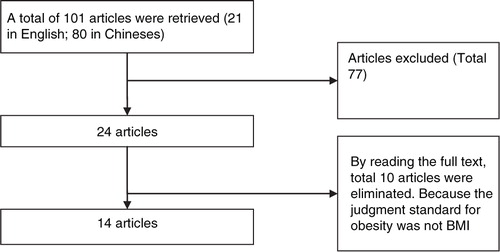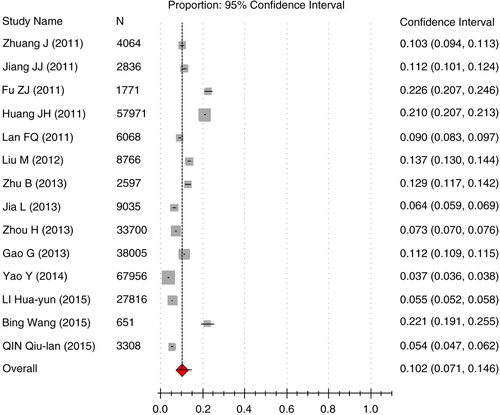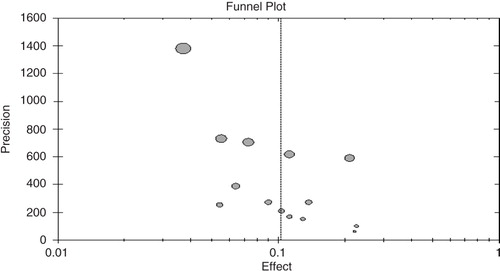Abstract
Background
In recent years, obesity has become a major public health problem worldwide. It has been estimated that 8% of children are obese. This study evaluates the overall prevalence of obesity in primary students in recent years.
Methods
Publications from 2011 and 2015 on the obesity prevalence among primary school students aged 6 to 12 in China were retrieved from the databases PubMed and Wanfang Data. Obesity was defined using the International Obesity Task Force standard body mass index cutoff points established for children. MetaAnalyst 3.13 software was used to calculate the total prevalence of obesity among primary school students in recent years.
Results
After evaluation of the quality of the articles, 14 papers were finally included in our study. The pooled prevalence of obesity in students aged 6 to 12 is 10.2% (95% CI: 7.1–14.6%).
Conclusion
Our results indicate that obesity is prevalent in students aged 6 to 12 in China. We believe that appropriate measures should be taken to control this situation.
Globally, there is a rising prevalence of overweight and obesity in both developing and developed countries (Citation1). Along with developing countries over the past 30 years, recent data suggest that the prevalence of childhood obesity in China is plateauing and may be increasing (Citation2).
Some studies observed that obesity is associated with increased blood pressure (Citation3, Citation4), breast cancer (Citation5), asthma (Citation6, Citation7), diabetes mellitus (Citation8, Citation9), hypertension (Citation10), coronary artery disease (Citation11), and dental caries (Citation12–Citation14). A previous study showed that the prevalence of obesity in Chinese children and adolescents was still considered to be relatively low (Citation15). Obesity has a greater prevalence among white children than among the Han Chinese, exacerbating existing disparities (Citation4, Citation5).
In the context of these reports, we updated an earlier meta-analysis of obesity among Chinese schoolchildren aged 6 to 12 (Citation16, Citation17). That earlier analysis found the prevalence of obesity in primary school students to be 10.0% and 10.4% (Citation16, Citation17). Our objective was to examine obesity trends among children in recent years.
However, there have been few studies documented in the literature in this part of China that assess the prevalence of overall obesity. Thus, the purpose of this study was to assess the prevalence of obesity in the past 5 years.
Materials and methods
Literature retrieval
Related publications on obesity published from 2011 and 2015 were selected from the PubMed and Wanfang Data databases with the keywords obesity, students, primary, and China in Chinese for the Chinese database and in English for PubMed. Eligible full texts were retrieved manually from the previous data.
Criteria
The literature met the following criteria: 1) papers included on the obesity among students aged 6 to 12 in China were published between 2011 and June 2015; 2) articles focused on discussion of the prevalence of obesity in China among primary students; and 3) overweight and obesity were defined using the International Obesity Task Force standard (IOTF) body mass index cutoff points established for children (Citation18). Exclusion criteria included 1) the indicators described in articles with less association or data being incomplete; 2) duplicate articles.
Literature screening and quality assessment in process
Each study was assessed by two investigators independently. Blinding was used to ensure quality. The related literature was retrieved on basis of the keywords described previously and initially selected by appraising the title and scanning the abstracts. Data extraction was performed for papers verified to be eligible. Evaluation of the article quality was performed as a meta-analysis of observational studies in epidemiology proposed by Stroup et al. (Citation19).
Statistical analysis
MetaAnalyst 3.13 software (Citation20) was used for performing meta-analysis. As a heterogeneity test, the random effects model was applied to evaluate the overall prevalence of obesity in school-aged children.
Results
Basic information and quality assessment of the articles
A total of 131 articles were retrieved from the online Chinese periodical full-text databases VIP, Wanfang Data, and CNKI, as well as PubMed. Quality assessment was made by meta-analysis of observational studies in epidemiology (Citation19). shows the process of literature screening, and the basic information on the final articles is shown in .
Table 1 Characteristics of the studies included
Meta-analysis of the prevalence of obesity among primary school students in China
A heterogeneity test was carried out on the obesity detection rate, with a result of I 2=0.500, suggesting that the research results in the 14 papers were heterogeneous. The random effects model was used for meta-analysis. As shown by the forest plot in , the results suggested that the pooled prevalence of obesity in primary school students is 10.2% (95% CI: 7.1–14.6%).
Publication bias
Publication bias is a tendency on the part of investigators to submit, or reviewers and editors to accept, manuscripts containing results that appear statistically significant. Although a potential threat in meta-analysis, it may be verified with funnel plots, which were applied to modify the possible bias in our literature selection. Verification by funnel plot () showed that the literature included was more or less symmetrical.
Discussion
Our results indicated that the obesity prevalence status in China was still troublesome: the pooled prevalence of obesity in primary school students is 10.2% (95% CI: 7.1–14.6%). This result is consistent with our previous study (Citation16, Citation17) and lower than the 20.3% obesity prevalence in the United States (Citation35, Citation36). In Greece, the prevalence of obesity is also high but shows a decreasing trend (Citation37). The prevalence of obesity is different in different areas of China. The overall prevalence rates of overweight and obesity were higher in northern areas than in other areas (Citation38). Detailed reasons for this trend should be investigated in future studies.
Although the figure from our meta-analysis (mean 10.2%) is not as high as reports from Western nations, the prevalence in mainland China is still troublesome, because the situation will worsen if we fail to take timely, effective preventive and control measures. We must be highly aware of the seriousness of the situation, and our educational departments and health authorities should jointly take effective and practical measures, such as health education and regular physical examination. Moreover, parents should be educated about the importance of healthy eating and students encouraged to get more exercise and shape good living habits.
Limitations
This study provides the status of childhood obesity from 2011 to 2015 in China. Our meta-analysis had some limitations. The data included are from published papers; some publication bias may exist. For example, genetic susceptibility may have an effect on childhood obesity in China. Therefore, obtaining more reliable obesity prevalence data on elementary school students in China requires further investigation. Our conclusions were limited by poor reporting in the studies included. Our review was also limited by significant heterogeneity, which we addressed by random effects meta-analysis and predefined subgroup analyses. This heterogeneity appears to be mainly due to differences in criteria, education level, economic status, and ethics of subjects.
Strengths of the study
Several important outcomes were reported in this study. The prevalence of obesity in primary school students is moderately high. Although it is lower than in most Western countries, no decreasing trend for obesity prevalence was noted in China.
Conclusion
Our results indicated that the obesity prevalence in China was still problematic very recently and that we should do more to improve the situation. More public health work is also needed to improve the current status of obesity in school-aged students.
Conflict of interest and funding
The authors have not received any funding or benefits from industry or elsewhere to conduct this study.
References
- Haidar YM, Cosman BC. Obesity epidemiology. Clin Colon Rectal Surg. 2011; 24: 205–10. [PubMed Abstract] [PubMed CentralFull Text].
- Dong B, Wang Z, Wang HJ, Ma J. Population attributable risk of overweight and obesity for high blood pressure in Chinese children. Blood Press. 2015; 24: 230–6. [PubMed Abstract].
- Dong J, Guo XL, Lu ZL, Cai XN, Wang HC, Zhang JY, etal. Prevalence of overweight and obesity and their associations with blood pressure among children and adolescents in Shandong, China. BMC Public Health. 2014; 14: 1080. [PubMed Abstract] [PubMed CentralFull Text].
- Zhang YX, Zhao JS, Chu ZH, Zhou JY. Prevalence of elevated blood pressure is associated with the increasing prevalence of obesity among children and adolescents in Shandong, China. Int J Cardiol. 2015; 201: 150–1. [PubMed Abstract].
- Petekkaya I, Sahin U, Gezgen G, Solak M, Yuce D, Dizdar O, etal. Association of breast cancer subtypes and body mass index. Tumori. 2013; 99: 129–33. [PubMed Abstract].
- Jensen ME, Wood LG, Gibson PG. Obesity and childhood asthma – mechanisms and manifestations. Curr Opin Allergy Clin Immunol. 2012; 12: 186–92. [PubMed Abstract].
- Fedele DA, Janicke DM, Lim CS, Abu-Hasan M. An examination of comorbid asthma and obesity: assessing differences in physical activity, sleep duration, health-related quality of life and parental distress. J Asthma. 2014; 51: 275–81. [PubMed Abstract].
- Das P, Bhattacharjee D, Bandyopadhyay SK, Bhattacharya G, Singh R. Association of obesity and leptin with insulin resistance in type 2 diabetes mellitus in Indian population. Indian J Physiol Pharmacol. 2013; 57: 45–50. [PubMed Abstract].
- ó Hartaigh B, Jiang CQ, Bosch JA, Zhang WS, Cheng KK, Lam TH, etal. Independent and combined associations of abdominal obesity and seated resting heart rate with type 2 diabetes among older Chinese: the Guangzhou Biobank Cohort Study. Diabetes Metab Res Rev. 2011; 27: 298–306.
- Rodilla E, Costa JA, Martin J, Gonzalez C, Pascual JM, Redon J. Impact of abdominal obesity and ambulatory blood pressure in the diagnosis of left ventricular hypertrophy in never treated hypertensives. Med Clin (Barc). 2014; 142: 235–42. [PubMed Abstract].
- Bechlioulis A, Vakalis K, Naka KK, Bourantas CV, Papamichael ND, Kotsia A, etal. Paradoxical protective effect of central obesity in patients with suspected stable coronary artery disease. Obesity (Silver Spring). 2013; 21: E314–21. [PubMed Abstract].
- Chiu SH, Dimarco MA, Prokop JL. Childhood obesity and dental caries in homeless children. J Pediatr Health Care. 2013; 27: 278–83. [PubMed Abstract].
- Costacurta M, Di Renzo L, Bianchi A, Fabiocchi F, De Lorenzo A, Docimo R. Obesity and dental caries in paediatric patients. A cross-sectional study. Eur J Paediatr Dent. 2011; 12: 112–16. [PubMed Abstract].
- D'Mello G, Chia L, Hamilton SD, Thomson WM, Drummon BK. Childhood obesity and dental caries among paediatric dental clinic attenders. Int J Paediatr Dent. 2011; 21: 217–22. [PubMed Abstract].
- Ji CY, Sun JL. [Analyses of the epidemiological status of overweight and obesity in Chinese students and the prevalence changes in recent 15 years]. Beijing Da Xue Xue Bao. 2004; 36: 194–7. [PubMed Abstract].
- He F, Liu J. Prevalence of obesity among primary students from 2009 to 2014 in China: an update meta-analysis. Int J Clin Exp Med. 2014; 7: 5348–52. [PubMed Abstract] [PubMed CentralFull Text].
- Qi Y, Yu Y, Li K, Chen Z, Liu Y, Zhang H. Prevalence of obesity among primary students between 2009 to 2014 in China: a meta-analysis. Nutr Hosp. 2014; 31: 185–90. [PubMed Abstract].
- Cole TJ, Bellizzi MC, Flegal KM, Dietz WH. Establishing a standard definition for child overweight and obesity worldwide: international survey. BMJ. 2000; 320: 1240–3. [PubMed Abstract] [PubMed CentralFull Text].
- Stroup DF, Berlin JA, Morton SC, Olkin I, Williamson GD, Rennie D, etal. Meta-analysis of observational studies in epidemiology: a proposal for reporting. Meta-analysis of Observational Studies in Epidemiology (MOOSE) group. JAMA. 2000; 283: 2008–12. [PubMed Abstract].
- Wallace BC, Schmid CH, Lau J, Trikalinos TA. Meta-analyst: software for meta-analysis of binary, continuous and diagnostic data. BMC Med Res Methodol. 2009; 9: 80. [PubMed Abstract] [PubMed CentralFull Text].
- Zhuang J. Analysis on obesity among primary school students in Chaozhou. Milit Med J S China. 2011; 37: 50–5.
- Jiang Y, Zhao H. Analysis influencing factors among primary school students obesity in Jian. Chinese J Public Health Eng. 2011; 10: 433–4.
- Fu J, Fan H, Si M, Qi D, Lin K. Prevalence of overweight and obesity among 7–12 year-old students in one center districts in Shanghai. Chinese J School Health. 2011; 32: 1341–3.
- Huang J, Huang H, Ma L, Qing Y. Prevalence of overweight among students in Dongcheng district. Capital J Public Health. 2011; 5: 173–5.
- Lai F, Ou Z, Ouyang X, Wang H, Li H, Fan W. Investigation on overweight and obesity of middle and primary school students in the Longgang district of Shenzhen[J]. J Trop Med. 2011; 11: 799–801.
- Liu M. Investigation of the prevalence of obesity among pupils in Lengshuitan District, Yongzhou City. Pract Prevent Med. 2012; 19: 1035–6.
- Zhu B, Cai X. Survey and influencing factors of overweight and obesity of pupils in Zhoushan City. Chinese J Gen Med. 2003; 11: 1099–110.
- Jia L, Wang L, Shan R, Lin Y. prevalence of overweight and obesity in primary school students in Wenzhou City and the analyses of the risk factors. J Hyg Res. 2013; 42: 269–72.
- Zhou H. Investigation and analysis of the current situation of children's obesity in Dongguan town of Changping City. J Qiqihar Med Coll. 2013; 34: 12–13.
- Gao G, Chen X, Wang G, Zhou Z. The analysis on the overweight and obesity among primary students in Wuzhong district. Chinese Prim Health Care. 2013; 27: 111–13.
- Yao Y, Ren X, Song X, He L, Jin Y, Chen Y, etal. The relationship between dental caries and obesity among primary schoolchildren aged 5 to 14 years. Nutr Hosp. 2014; 30: 60–5. [PubMed Abstract].
- Hua-Yun L, Qiong-Hun W. Investigation and analysis on the status of pupils overweight and obesity in Luquan county. Soft Sci Health. 2015; 29: 307–9.
- Bin W, Zhuanxi T, Xing W, Ying Z, Qingwu J. Factors associated with different types of obesity among primary school students in Shanghai. Chinese J School Health. 2015; 36: 402–5.
- Qiu-Lan Q, Hong Y. Association of lifestyle and overweight/obesity among urban school-age children in Guangxi. Chinese J School Health. 2015; 36: 549–55.
- Robbins JM, Mallya G, Wagner A, Buehler JW. Prevalence, disparities, and trends in obesity and severe obesity among students in the school district of Philadelphia, Pennsylvania, 2006–2013. Prevent Chronic Dis. 2015; 12: E134.
- Robbins JM, Mallya G, Polansky M, Schwarz DF. Prevalence, disparities, and trends in obesity and severe obesity among students in the Philadelphia, Pennsylvania, school district, 2006–2010. Prevent Chronic Dis. 2012; 9: E145.
- Kleanthous K, Dermitzaki E, Papadimitriou DT, Papaevangelou V, Papadimitriou A. Overweight and obesity decreased in Greek schoolchildren from 2009 to 2012 during the early phase of the economic crisis. Acta Paediatr. 2015. [Epub ahead of print]..
- Xie S, Wang J, Li N, Jiang W, Yang S, Li X, etal. Survey on overweight and obesity of preschool children in rural areas from ten provinces of China. Zhonghua Liu Xing Bing Xue Za Zhi. 2014; 35: 425–8. [PubMed Abstract].



